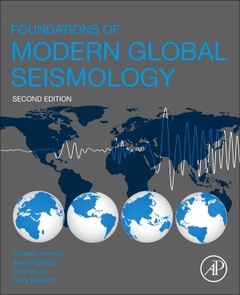Description
Foundations of Modern Global Seismology (2nd Ed.)
Authors: Ammon Charles J., Velasco Aaron A., Lay Thorne, Wallace Terry C.
Language: English
Subject for Foundations of Modern Global Seismology:
Keywords
Adjoint waveform; body waves; Earth structure; earthquake ruptures; earthquakes; explosions; forward modeling; free oscillations; Global seismology; imaging sources and Earth structure; plate tectonics; radiation pattern; seismic tomography; seismic waves; seismograms; source time functions; surface waves; tsunamis; waveform modeling
132.33 €
In Print (Delivery period: 14 days).
Add to cart604 p. · 19x23.3 cm · Paperback
Description
/li>Contents
/li>Readership
/li>Biography
/li>Comment
/li>
Part 2: Theory and Application10. Foundations of Elasticity and Fracture11. Elastic Waves12. Body Waves and Ray Theory - Travel Times13. Body Waves and Ray Theory - Amplitudes14. Surface Waves15. Surface Waves on a Sphere and Free Oscillations16. Ground Deformation and Wave Excitation17. Seismic Point Source - Models18. Finite Kinematic Earthquake Models19. Seismic Waveform Modeling20. Imaging the Earth with Travel Times21. Imaging the Earth Using Seismic Waveforms
Researchers, upper-division undergraduate and first-year graduate students in earth science, geophysics, geology, seismology, and applied mathematics/mechanics
Dr. Aaron A. Velasco is Professor of Geological Sciences at the University of Texas at El Paso. His current research interests have spanned a variety of subjects in seismology, including investigations of dynamic triggering of earthquakes, determining 3-D Earth structure from analysis of multiple data sets, deploying seismic sensors for studying aftershocks, studying geothermal prospects, and he has a particular interest in promoting opportunities for minority students in science. He has worked in a variety of positions in the private sector (Science Applications International Corporation), a federal research laboratory (Los Alamos National Laboratory), and currently for a university (University of Texas at El Paso). Besides his professor position, he also serves as State Seismologist for Texas for the Texas Railroad Commission.
As a Professor at U.C. Santa Cruz and Director of the Centre for the Study of Imaging and Dynamics of the Earth, Thorne Lay's primary research interests involve analysis of seismic waves to interrogate the deep structure of the Earth's interior and to study the physics of earth
- Includes more than 400 illustrations, from both recent and traditional research articles, to help readers visualize mathematical relationships, as well as boxed features to explain advanced topics
- Offers incisive treatments of seismic waves, waveform evaluation and modeling, and seismotectonics, as well as quantitative treatments of earthquake source mechanics and numerous examples of modern broadband seismic recordings
- Covers current seismic instruments and networks and demonstrates modern waveform inversion methods
- Includes extensive, updated references for further reading new to this edition
- Features reorganized chapters split into two sections, beginning with introductory content such as tectonics and seismogram analysis, and moving on to more advanced topics, including seismic wave excitation and propagation, multivariable and vector calculus, and tensor approaches
- Completely updated references and figures to bring the text up to date Includes all-new sections on recent advancements and to enhance examples and understanding Split into shorter chapters to allow more flexibility for instructors and easier access for researchers, and includes exercises




